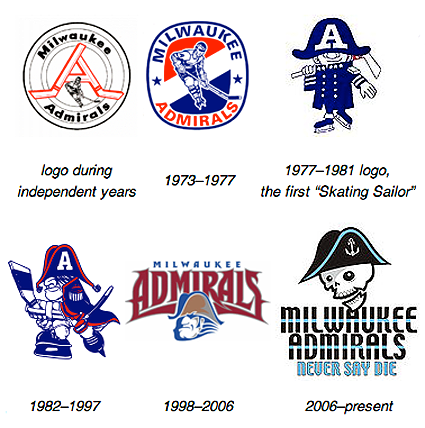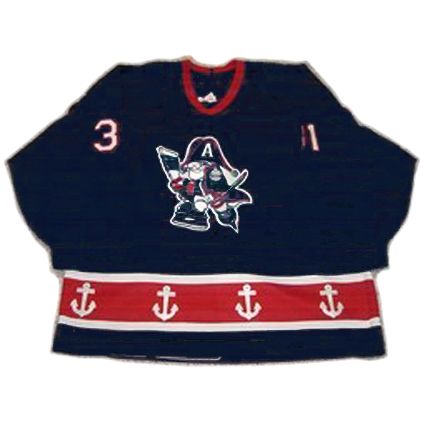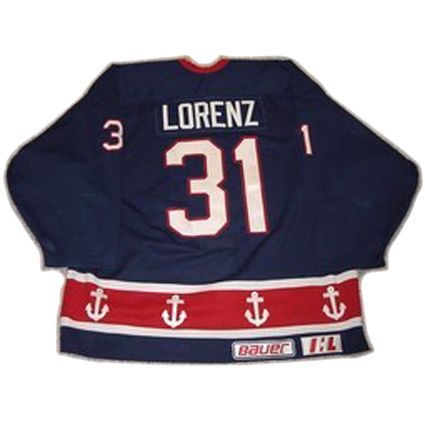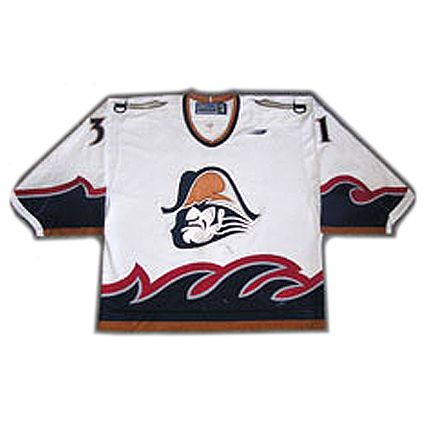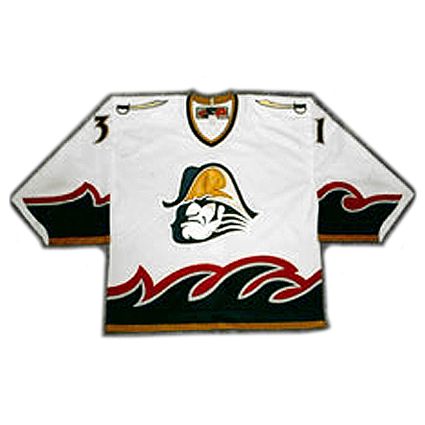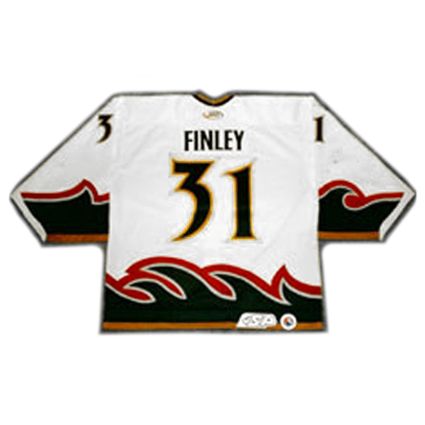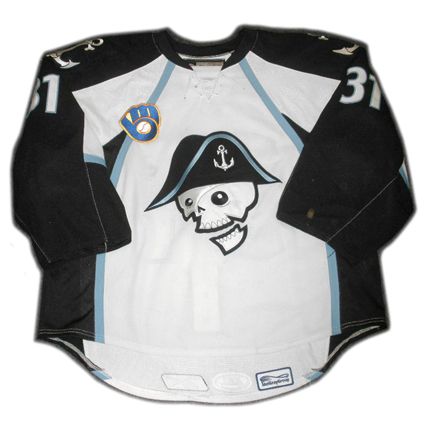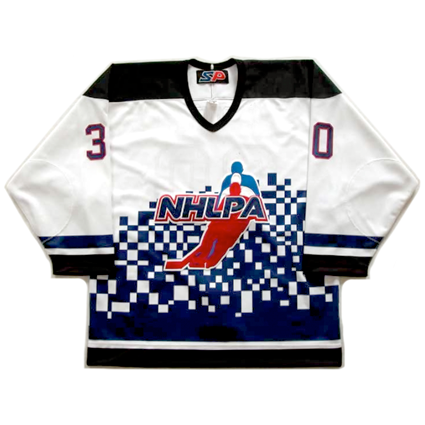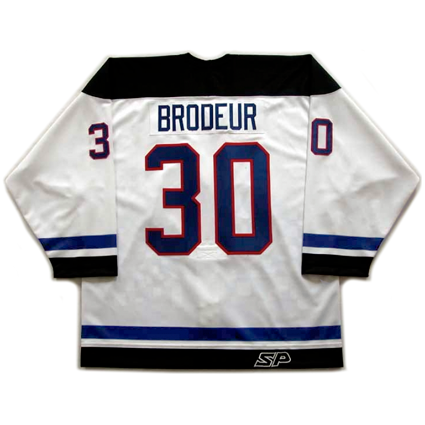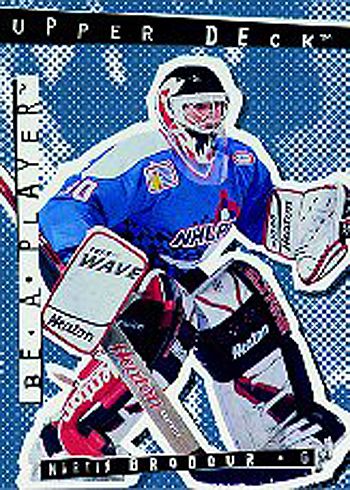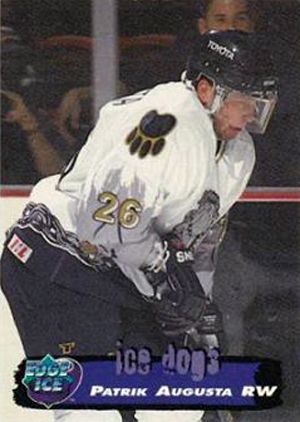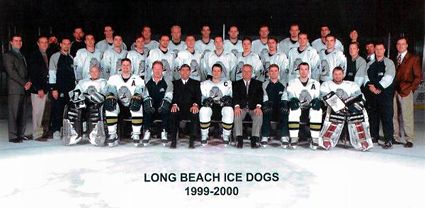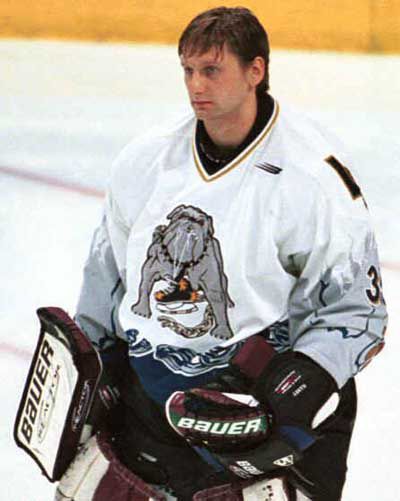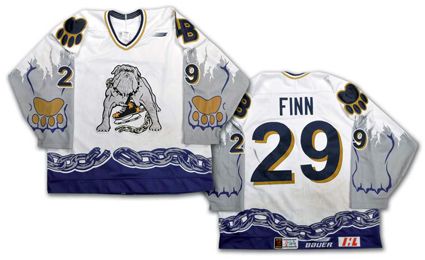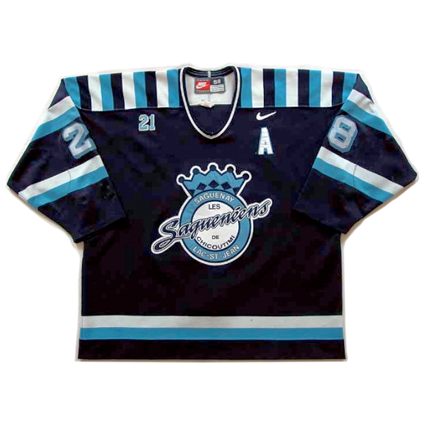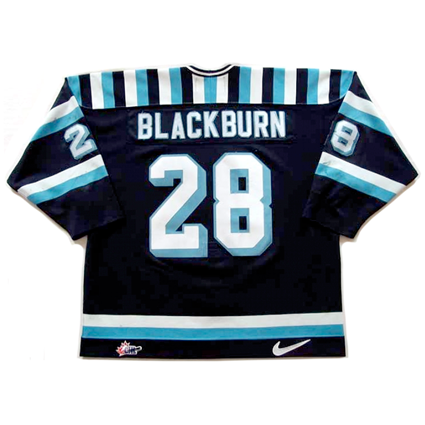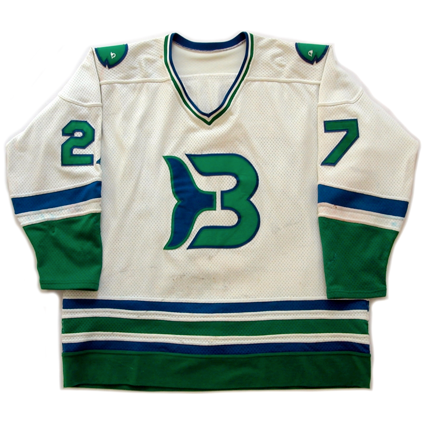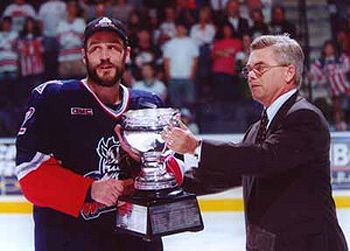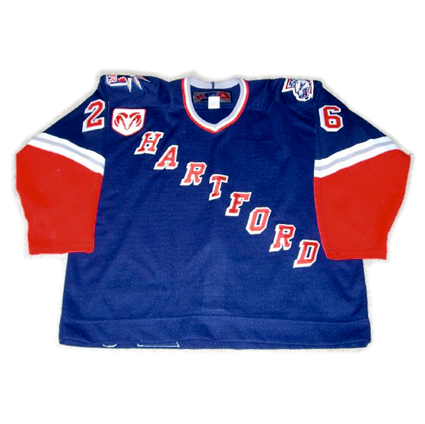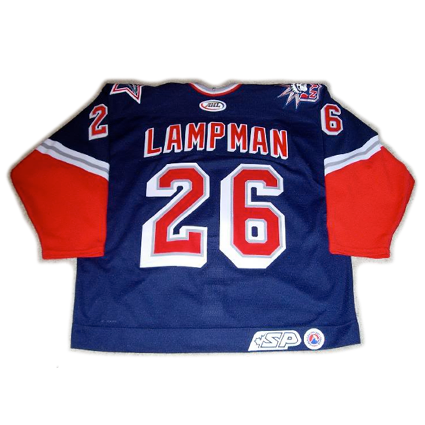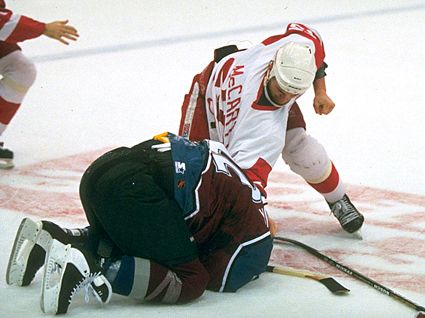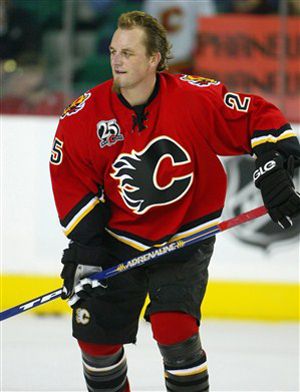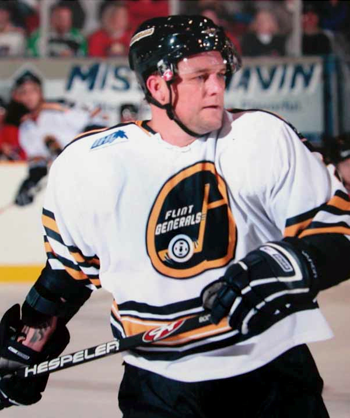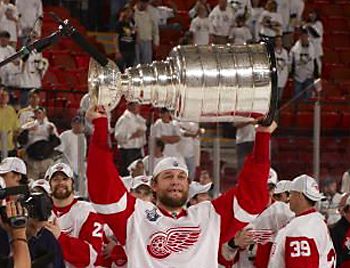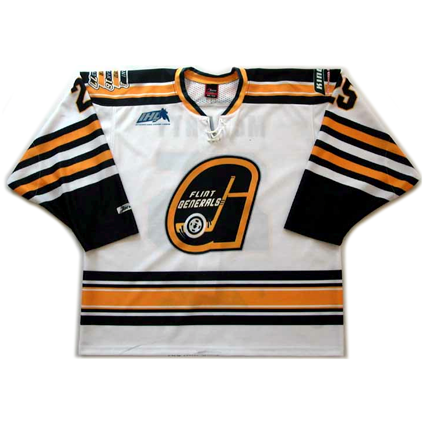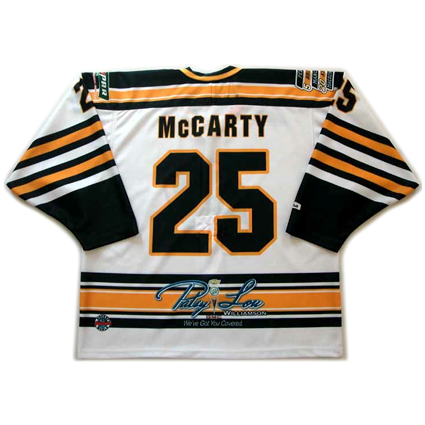Saturday, July 31, 2010
1996-97 Milwaukee Admirals Danny Lorenz Jersey
July by the Numbers concludes with a stop on the shores of Lake Michigan for jerseys #31.
The Milwaukee Admirals were founded as an amateur club in 1970 known as the Milwaukee Wings. The next season the team was sold to a group of investors, one of whom owned an appliance store and renamed the team the "Admirals" after a brand of appliances sold in his store. Thankfully the club adopted the naval aspect of the Admirals name and did not use a washing machine for their logo!
For the 1973-74 season the team joined the United States Hockey League (USHL), which at the time was a senior league. They won the USHL championship in 1976 and continued to play in the league for one more season prior to the league evolving into an amateur junior hockey league.
For the 1977-78 season, the Admirals joined the International Hockey League where they would play for 24 seasons. It would take five seasons for the Admirals to post a winning record and six for them to win their first division title in 1982-83.
While they would finish second in 1983-84, they would set a new team record with their first 100 point season with 101 with a 46-30-6 record. After a last place finish in the then nine team IHL in 1984-85, the Admirals would rebound immediately with a team record 102 point season. Their roller coaster ride up and down the standings continued with a 32 point drop in the standings and a further 19 less in 1987-88, leaving the club with a mere 49 points from 82 games and a distant last place in the IHL. The Admirals again rocketed up the standings with a 64 point increase in 1988-89 to set another new club record of 113 points, which still stands today.
During the remainder of their time in the IHL, which rapidly grew from 10 teams in 1991-92 to 19 teams in 1995-96, the Admirals won division titles in 1993, 1995 and 1996. Playoff success eluded Milwaukee though, as, while they qualified for the playoffs in 22 out of 24 seasons, they only made it past the first round of the playoffs just five times and won only two of those series. Their second round playoff victory in 1983 propelled them into their only appearance in the Turner Cup Finals, where they fell in six games to Toledo.
With the IHL now falling on hard times, having shrunk from 19 teams in 1996-97 down to just 11 four seasons later, the league eventually ceased operations altogether, and the Admirals were one of six clubs to join the American Hockey League in 2001.
After two seasons of finding their way in the AHL (which already had a member club named the Admirals!), Milwaukee reached 100 points for the first time in 11 seasons during 2003-04 with 102 to gain their first AHL division title. In the Calder Cup playoffs, they outlasted Cincinnati in seven games, downed Chicago in six, ousted Rochester in five and continued their string of playing one less game each round by sweeping Wilkes-Barre/Scranton in four to capture the franchise's first Calder Cup and their first championship of any kind since 1976, a 28 year wait.
A 103 point season preceded a 108 point campaign in 2005-06, the Admirals best so far while in the AHL, and a second trip to the Calder Cup Finals in 2006, although Milwaukee fell in six games to Hershey. The Admirals are currently riding a eight season playoff streak through 2009-10 and have three division titles in their nine AHL seasons.
The Admirals have retired five numbers throughout their history, those of #9 for Phil Wittliff, #14 for both Mike McNeill and Fred Berry (the Admirals all-time assists leader with 379), #26 for Tony Hrkac, #27 of Danny Lecours (whose nine seasons are a club record, as are his 360 goals and 642 points) and #44 for Gino Cavallini and Kevin Willison.
Today's featured jerseys show the evolution of the Milwaukee Admirals from the early 1980's to their modernization in the late 90's and move to the AHL and finally their recent redesign in the early 2000's.
First up is a 1996-97 Milwaukee Admirals Danny Lorenz jersey. This simple style is a solid blue jersey with a single red waist stripe trimmed in white with white anchors repeating around the waist. It's decorated with the cartoonish skating Admiral logo and has no secondary logos and just a basic block font for the name and numbers. This classic Admirals jersey can be traced back to the 1970's and remained in use until 1998.
While still members of the IHL, the Admirals jerseys underwent a much needed modernization in 1998, which led to our second featured style, a 1999-00 Milwaukee Admirals Mike Buzak jersey. This jersey was much more in-your-face, with it's overly dramatic wave treatment of the waist striping and more tempered sleeve waves. The new main logo was an iron-jawed, very stern looking Admiral head with a giant chin and an enormous drop shadow on the left. The overall effect was a quite mean looking character who was difficult to embrace. The jerseys received secondary logos in the form of a saber appearing on each shoulder and a new stylized number font which was reminiscent of the sabers on the shoulders.
All of this was rendered in a new color scheme, with the basic blue and red evolving into a classier navy blue and dark red with copper and silver accents.
The jersey remained the same through the Admiral's move to the AHL, save for the league logo on the rear hem, as seen on this 2002-03 Milwaukee Admirals Brian Finley jersey.
This jersey style lasted until 2006, when the Admirals underwent a complete redesign, changing their team colors once again and introducing an all new, more juvenile skeleton pirate theme clearly aimed at moving more merchandise to younger fans.
This jersey introduced a new light blue, grey and black color scheme and all new, modern fonts for the names and numbers. After one season with a standard jersey cut, the AHL changed over to the new Reebok Edge System of jerseys, resulting in a slightly new jersey with the "apron strings" piping cutting across the chest of the jersey as shown in this 2008-09 Milwaukee Admirals Mark Dekanich jersey.
The Admirals also went against convention with their unconventional grey road jersey, a choice perhaps influenced by their recent ownership change, led by the owner of the Milwaukee Brewers baseball club, Mark Attanasio, as baseball teams historically wear grey on the road, a color seldom, if ever, used for hockey jerseys, especially in the professional ranks.
Today's video segment begins with the Milwaukee Admirals winning the 2004 Calder Cup while wearing their "second generation" jerseys.
Here, Brewers announcer Bob Uecker shows his love for the Admirals.
Finally, a look at the Admirals light blue alternate jerseys in some typical minor league fisticuffs.
Labels:
IHL,
Milwaukee Admirals
Friday, July 30, 2010
1994 NHLPA Martin Brodeur Jersey
July by the Numbers shows it's solidarity with jersey #30.
Back in 1994 the National Hockey League Players Association (NHLPA) was locked out by the club owners due to labor issues regarding the implementation of a salary cap, which the players opposed. The lockout began on October 1, 1994 and lasted until January 11, 1995.
As the lockout continued, the NHLPA organized a tournament called the "4-on-4 Challenge" over three days from November 10th to 12th, 1994 at the Copps Coliseum in Hamilton, Ontario.
Four teams took part in the event, Team Ontario, Team USA, Team Western Canada and Team Quebec with the tournament won by Team Ontario. The tournament had many NHL stars in attendance, with Patrick Roy, Luc Robitaille, Brett Hull, Joe Sakic, Doug Gilmour, Rob Blake and John Vanbiesbrouck among those competing. In total, over a half a million dollars was raised in support of the Ronald McDonald Children's Charities of Canada and minor hockey associations throughout North America.
Today's featured jersey is a 1994 NHLPA Team Ontario Martin Brodeur jersey. During the tournament players born in Western Canada wore yellow jerseys, players born in the United States wore red jerseys, players born in the Quebec wore blue jerseys and the players born in the Ontario wore white jerseys.
About now we can hear you saying "But Martin Brodeur was born in Quebec. Why is his name on a white Ontario jersey?"
That's because the owner of this jersey did not do his proper research before committing Brodeur's name to this jersey.
Martin Broduer 94-95 Be A Player #R58 trading card
showing Brodeur in a blue Quebec jersey
Things brings up a point we'd like to stress. One of the things we enjoy the most about collecting jerseys is doing our research. It's often a challenge, particularly when collecting international jerseys when trying to determine:
- In what years was a particular style worn?
- Can any additional patches be added to the jersey based on when it was used?
- Who wore the jersey during those years?
- What numbers did the players wear?
- Did he wear a "C" or an "A"?
- What fonts were used for the names and numbers?
Additionally,
- Is any additional patch even available?
- Where can I obtain the patch?
- What was accomplished while wearing the jersey? A championship or personal milestone?
- Is the brand of jersey correct for the year I'd like to replicate?
- Where on Earth can I find an illustration or photo of the player I've chosen wearing the jersey to confirm any of the above questions?
One place to start is right over there to your right on this page, "Our Favorite Hockey Links", which contain links to some of the most critical, informative and dependable sources for our research.
There's probably not a day that goes by that we don't find ourselves at the essential NHLUniforms.com. Every NHL jersey illustrated, with additional patches, since the dawn of the league in 1917. What more can you ask for? Speaking of patches, NHLPatches.info is another excellent resource for all things NHL patch related.
The Internet Hockey Database is where you will find rosters for nearly every team ever, and what you can't find there usually be found at EuroHockey.net. We also rely on the past tournaments section of the IIHF website.
When it comes time for photos, other than a basic Google Image Search, Getty Images is the place to go. Sure the images are all watermarked, but for our purposes you simply cannot beat the wealth of visual information contained there.
And if you can't find what you need on your own, check out one of the forums we have linked to and conduct a search of their archives, Gameworn.net in particular, or join one of the communities and ask.
It's one thing to buy a jersey already customized, as long as you are comfortable that it's been done correctly, or at least close enough to make you happy, but there's a real pride in ownership we get from buying a blank jersey and conducting our own research into all the factors listed above, choosing a customizer to letter it for us and finally getting the completed jersey back done precisely to our specifications that buying a fully completed jersey just can't touch.
Today's video section features some of the action from the NHLPA 4-on-4 Challenge from November of 1994 when the players were locked out by the owners and staged a charity tournament which raised over a half a million dollars for charity.
Labels:
Brodeur Martin,
NHLPA 4-on-4 Challenge
Thursday, July 29, 2010
1997-98 Long Beach Ice Dogs Steve Finn Jersey
July by the Numbers once more crosses the continent, this time to California for jersey #29.
The Long Beach Ice Dogs came to be when the San Diego Gulls of the International Hockey League moved to Los Angeles for the 1995-96 IHL season and changed their name to the Ice Dogs after five years in San Diego where they made the Turner Cup Finals once following a stellar 62-12-8 regular season record.
After one season playing at the Los Angeles Memorial Sports Arena, the club moved 22 miles south to the Long Beach Sports Arena and altered their name to the Long Beach Ice Dogs. After missing the playoffs their previous season up the road in Los Angeles, the 1996-97 Ice Dogs had a great debut season in Long Beach, going 54-19-9 in the regular season led by Patrik Augusta's 87 points in 82 games and Stephane Morin's 82 points in 65 games after arriving from the Manitoba Moose.
In the playoffs the Ice Dogs defeated Milwaukee in three straight and sweeping the Utah Grizzlies in four. After knocking out the Houston Aeros in five, the Ice Dogs advanced to the finals where they faced the Detroit Vipers, who downed Long Beach in six games.
Their next regular season was a near carbon copy of the previous one when they posted a 53-20 -9 record to again win their division. Augusta again led the club with 41 goals and 81 points followed by Dan Lambert's 78 points. Their quest for the Turner Cup started out well with a defeat of Las Vegas 3-1 before outlasting Kansas City by winning in overtime of Game 7 as the teams alternated victories throughout the series. The Ice Dogs run came to an end when they lost out to the eventual champion Chicago Wolves in six games.
Patrik Augusta
Augusta once more led the team in scoring in 1998-99 with 59 points, his drop in points due to being limited to 68 games that season. Long Beach advance past the first round of the playoffs by knocking out Kansas City once again 2-1 but had their season ended by division champion Houston Aeros in five games.
The 1999-00 Long Beach Ice Dogs, their final season in the IHL
The Ice Dogs final season in the IHL saw them led in scoring by Pavel Rosa with 53 points with future Stanley Cup winner Nikolai Khabibulin getting the majority of starts in goal. In 33 starts he went 21-11-1 with an excellent goals against average of 1.83. In the playoffs Long Beach quickly eliminated Manitoba 2-0 but were swept by Chicago in four to end their time in the IHL.
It was at this point that the team owner withdrew the club from the IHL and dropped the club down to the West Coast Hockey League for the 2000-01 season, where they played three seasons before entering the East Coast Hockey League following the demise of the WCHL.
The Ice Dogs completed in the ECHL for another four seasons before ownership shut down the club due to ongoing financial losses due to poor attendance after 17 seasons, three cities and three different leagues, somewhat representative of life in the often unsettled and unstable minor leagues.
Notable players to have skated for the Ice Dogs include goalies Manny Legace, Khabibulin and Jaroslav Halak and defenseman Jaroslav Modry.
Today's featured jersey is a 1997-98 Long Beach Ice Dogs Steve Finn jersey. This jersey is a prime example of the humor found in some minor league jerseys allowed by the dye-sublimation process. The clever dog chain across the bottom in place of a traditional stripe is a fun and effective way to gain attention and establish the team's visual identity on the ice.
The sleeves are less successful though, with the intent being that the white of the jersey has been torn away to reveal not the players arms, but the front legs of a bulldog, which just comes across as silly and not very well executed, as the legs on the front and the paws on the back of the arms are rendered so flatly and without much detail.
A wraparound "3-D" effort may have been more effective, but would have been better executed if the legs would have had a printed fur pattern and the sleeve color outside the arms being black or dark blue in order to be a different, more contrasting color than the dogs legs themselves.
We can see what they were trying to attempt, but it's execution was not very effective in action and they may have just been better off repeating the chain motif around the wrists for a less silly, more dignified look.
While this video isn't admittedly the greatest quality, you can see the torn sleeves effect, but just try to find the rendering of the legs and paws on the jerseys.
Labels:
IHL,
Long Beach Ice Dogs
Wednesday, July 28, 2010
2001-02 Chicoutimi Saguenéens Alexandre Blackburn Jersey
Juillet par les Numéros retour à Québec pour de maillot n ° 28.
The Chicoutimi Saguenéens (pronounced Sheh ku ta me Sa gwa nay ens) were founded in 1973 and their name means "the people from Saguenay, a region in central Quebec.
The "Sags" have twice won the President's Cup as the QMJHL's playoff championship, first in 1991 and again in 1994. By winning the league's playoff title, they advanced to the Memorial Cup playoffs. They also participated in the Memorial Cup in 1997 as runners up in the QMJHL when the winners from Hull were hosts of the tournament, but the ultimate prize in Canadian junior hockey has so far eluded Chicoutimi.
Four times in their history the Saguenéens have won division titles, those coming in 1988, 1991, 1994 and 2002. Their record for most points in a season came in 2005-06 when they racked up 51 wins and 106 points, made possible by a strong team defense which allowed a team record low 185 goals against.
Many former Saguenéens have gone onto play in the NHL, with Marc Bergevin, Marc Bureau, Guy Carbonneau, Gord Donnelly, Gilles Hamel, Alan Haworth, Stephane Richer and Andre Roy have all played over 500 NHL games in addition to goaltenders Marc Denis and Felix Potvin to continue the tradition of goaltenders from Chicoutimi, started by legendary native Georges Vezina.
Numbers retired by Chicoutimi include Alain Cote's #14, Normand Leveille's #16, Sylvain Locas' #18, Marc Fortier's #20 and #21 for Carbonneau and #29 for Potvin.
Guy Carbonneau 1979-80
Today's featured jersey is a 2001-02 Chicoutimi Saguenéens Alexandre Blackburn jersey. We have always found jerseys done in sky blue and navy blue with white trim to be among some of the most attractive jerseys and this one is no exception. It's unique striped shoulder yoke gives the jersey an shot of adrenaline even when not in use. It's also a hint of a classic turn of the century barberpole style without the dizzying full body effect. The choice of drop shadowed numbers also add to the classic appeal of this very attractive jersey with is classy main crest topped with a regal crown.
The jersey also has a tiny #21 on the upper right chest that many will assume is a memorial to a fallen player, but it is in fact a tribute to the very much alive and well Guy Carbonneau, whose jersey #21 was retired by the club that season. In a departure from the expected, the #21 is not sewn on with twill, but embroidered directly into the team's jerseys.
Labels:
Chicoutimi Sagueneens,
QMJHL
Tuesday, July 27, 2010
1982-83 Binghamton Whalers Dave McDonald Jersey
July by the Numbers stays in New York State and AHL, only traveling back in time for jersey #27.
They were renamed the Binghamton Dusters for three seasons until another name change, this time to the Binghamton Whalers in recognition of their parent club, the Hartford Whalers of the NHL, and even used the Hartford club's Brass Bonanza as their goal celebration song.
During their second season as the Whalers, the club won the South Division and made a successful playoff run, defeating Hersey 3-2 in five games and Rochester 4-1 to reach the Calder Cup Finals, the first for the franchise since 1974 while still in Providence.
Another division title followed in 1984-85, when the team put together a stellar 52-20-8 record for a Whalers best 112 points, led by Paul Gardner's 51 goals and 79 assists for a whopping 130 points in 64 games to lead the AHL in all three categories. His 130 points were 37 more than the next closest challenger, who played 12 more games than Gardner, and proved to be the all-time Whalers record.
The Hartford Whalers were never one of the better teams in the NHL, and as a result did not supply Binghamton with the greatest talent, and often called up their better players in an effort to improve their dismal placings in the NHL. As a result, the Binghamton Whalers fortunes began to sink, dropping in wins from 47 to 38, then 28 to miss the playoffs and finally the worst record in the history of the AHL when they went 11-60-9 in their final season as the Whalers in 1989-90.
The following season their affiliation changed from Hartford to the New York Rangers which resulted in yet another name change for the franchise to the Binghamton Rangers, ending their 10 seasons as the Whalers. After seven seasons as the Rangers, the club was relocated yet again to Hartford, Connecticut to fill the void left by the departure of the Hartford Whalers to North Carolina, where they would become the Hurricanes. Now in Hartford, taking the place of their once parent club, they became yesterday's featured club and jersey #26 in our July by the Numbers travels, the Hartford Wolf Pack.
Better known Binghamton Whalers players include goaltender Richard Brodeur, Sylvain Cote, Ray Ferraro, Lou Franceschetti, Marty Howe, Doug Jarvis, Pete Peeters, Ulf Samuelsson, Peter Sidorkiewicz and Steve Weeks.
Today's featured jersey is a 1982-83 Binghamton Whalers Dave McDonald jersey. Another example of a minor league club which adopted the basic jersey of their parent club, the Whalers pulled of one of the most simple, effective and clever tricks when they simply rotated the Whalers "whale tail" logo, which formed the letters "H" and "W", ninety degrees counterclockwise to create a "B" logo for Binghamton. They did modify the inside negative space that originally formed the bottom of the "H" to a rounded shape to enhance the "B" shape but otherwise left the Whalers clever logo intact.
They were also clever enough to maintain the use of the classic Pucky the Whale shouder patches.
Today's video is a little minor league mayhem, as Dale Kushner of the Springfield Indians leaves his penalty box early to fight with Al Teur, who still resides in the penalty box! Notice the Whalers "B" logo jerseys in the clip.
Labels:
AHL,
Binghamton Whalers
Monday, July 26, 2010
2003-04 Hartford Wolf Pack Bryce Lampman Jersey
July by the Numbers travels east for jersey #26.
When the Hartford Whalers of the NHL departed for North Carolina to become the Carolina Hurricanes, the professional hockey void in Hartford was filled by the relocation of the Binghamton Rangers of the AHL for he 1997-98 season.
The Rangers were renamed the Hartford Wolf Pack and remained the Rangers top farm club. During their 13 seasons in Hartford, the Wolf Pack have never had a losing record and qualified for the playoffs 12 consecutive seasons. Five times the club has topped 100 points in the standings, including a Wolf Pack best 110 in 2007-08.
In 1999-00, Hartford finished with the best record in the AHL with 107 points and were led in scoring by Derek Armstrong, whose 82 points were good for third overall in league scoring.
Hartford opened the Calder Cup playoffs with a first round 3-2 defeat of Springfield prior to knocking out Worcester 4-1. They then eliminated Providence 3-2 in overtime of Game 7 to advance to the Calder Cup Finals. In the finals, they met the Rochester Americans, who they defeated 4 games to 2 to capture their only Calder Cup championship with Armstrong being named as the playoff MVP.
The Wolf Pack have retired one number in their history, the #12 of Ken Gernander.
Gernander first played for the franchise in Binghamton in 1994-95 and came to Hartford with the franchise when it relocated. In all, he played for the franchise for 11 seasons and was team captain for ten of them. He was named the club's head coach in 2007.
Today's featured jersey is a 2003-04 Hartford Wolf Pack Bryce Lampman jersey. While many minor league teams have their own unique jersey sets, completely separate from their parent club, others adopt the look of their NHL big brothers, sometimes with very poor results aesthetically.
The Wolf Pack however, have a history of some of the most striking and attractive jerseys in all of minor league hockey, generally taking a basic jersey from their parent club the New York Rangers, and then apply a mix and match program of their own logo or wordmarks done in the classic Rangers dropshadowed font.
This particular example finds it's basis in the Rangers dark blue "Lady Liberty" alternate jersey. They then added the name "Hartford" in the Rangers traditional, diagonal style and finish it off with the name and number customization in the style of the Rangers jerseys to create an instantly familiar-looking, yet brand new style to great affect.
If anything, the Wolf Pack could be accused of overdoing it, as it seems like they have had more jerseys than nearly any team in recent memory. Documenting them all would be a research project that would certainly be a challenging undertaking, as nearly every basic jersey style seems to have been used with a rotation of "Hartford", "Wolf Pack" and the team's wolf head logo at some point!
Today's video segment is a look back at some of the early years of the Hartford Wolf Pack in anticipation of the 2002 playoffs.
This next video is their opening video from the 2009-10 season.
Labels:
AHL,
Hartford Wolf Pack
Sunday, July 25, 2010
2007-08 Flint Generals Darren McCarty Jersey
July by the Numbers returns to Michigan once again for jersey #25.
When one thinks of the minor leagues, the mental image is generally that of a young hopeful hoping to make it to the NHL for the first time. There are however, other reasons for players to find themselves on minor league rosters. Such was the case of then three time Stanley Cup champion Darren McCarty.
McCarty began his NHL career in 1993 with the Detroit Red Wings and was a vital part of the powerful Red Wings lineup for the next 11 seasons, which included Stanley Cup championships in 1997, 1998 and 2002. While not a flashy goal scorer, his contributions were his toughness, tenacity and team first approach, best recalled by his attack on Claude Lemeiux in retribution for Lemieux's savage hit on teammate Kris Draper.
McCarty did not play in the 2004-05 season of the NHL lockout when many players found jobs in European leagues or North American minor leagues. Following the lockout, a new salary cap system was instituted in the NHL and the Red Wings chose to buy out McCarty's contract as a result of the new financial structure in the post-lockout NHL.
McCarty then signed with the Calgary Flames as a free agent for 2005-06 and played in 67 games, scoring 13 points and registering 117 penalty minutes. McCarty went through some personal issues at the time and in 2006-07 he appeared in just 32 games for the Flames without registering a single point.
At the start of the 2007-08 season, he was without a team. A meeting with Draper in November started his return to hockey when Draper encouraged him to get back in shape and arranged for him to get a tryout with the Flint Generals of the International Hockey League, a team in which Draper is a part owner.
To clarify, this version of the IHL is not the one that existed from 1495 to 2001, but a new league founded in 1991 as the Colonial Hockey League with teams in Michigan and Ontario. As the league expanded eastward, it was renamed the United Hockey League in 1997 before resurrecting the International Hockey League name in 2007, as the original IHL had a strong presence in the Great Lakes area.
This league however was not at the same level as being one step below the NHL, and is considered the fourth rung on the ladder below the NHL, AHL and ECHL.
Nor was this version of the Flint Generals the same franchise which existed from 1969 to 1985 in the original IHL and won the Turner Cup in 1984. That club relocated to Saginaw, Michigan in 1985 and changed their name to the Saginaw Hawks in 1987 before folding in 1989.
McCarty then joined the Generals by signing a contract on December 31, 2007 and played in 11 games, scoring six points and adding 30 penalty minutes.
A little over a month later McCarty was signed by the Red Wings top minor league affiliate, the Grand Rapids Griffins of the AHL, and immediately impressed with a hat trick plus an assist in his first game for the Griffins.
After 13 games with Grand Rapids, McCarty was signed by the Detroit Red Wings and was called up by Detroit on March 7, 2008 in time to play three regular season games prior to the playoffs. The top-seeded Red Wings defeated the Nashville Predators 4 games to 2, swept the Colorado Avalanche in 4 and advanced to the Stanley Cup Finals by eliminating the Dallas Stars 4-2. They then captured the fourth Stanley Cup of McCarty's career by downing the Pittsburgh Penguins in six games to complete McCarty's comeback from being out of hockey six months earlier.
McCarty played one more season, splitting time between the Red Wings and the Griffins (while recovering from an injury and subsequent surgery) before ending his season and career back with Detroit to finish the season following the Griffins elimination from the playoffs.
The new version of the Flint Generals that McCarty began his comeback with came into being in 1993 and took the name of the previous club based on a vote of the fans. The team won the Colonial Cup in 1996 and again in 2000 before folding in 2010.
Even the IHL has ceased to exist, as the remaining five teams are set to join the Central Hockey League for the 2010-11 season as part of a merger between the leagues which will be known as the CHL.
Today's featured jersey is a 2007-08 Flint Generals Darren McCarty jersey worn during the start of McCarty's comeback attempt after starting the season without a job. The Generals wore an attractive jersey in the original Generals blue and gold colors in keeping with the dignity associated with the Generals name, unlike many minor league teams who have gaudy jerseys to go with their cartoonish logos and often ridiculous names, especially in the lower minors.
Today's video section begins with a look at McCarty's first game with the Generals and the postgame press conference.
Here is McCarty's comeback story as told by the CBC.
Labels:
Detroit Red Wings,
Flint Generals,
McCarty Darren
Subscribe to:
Comments (Atom)

